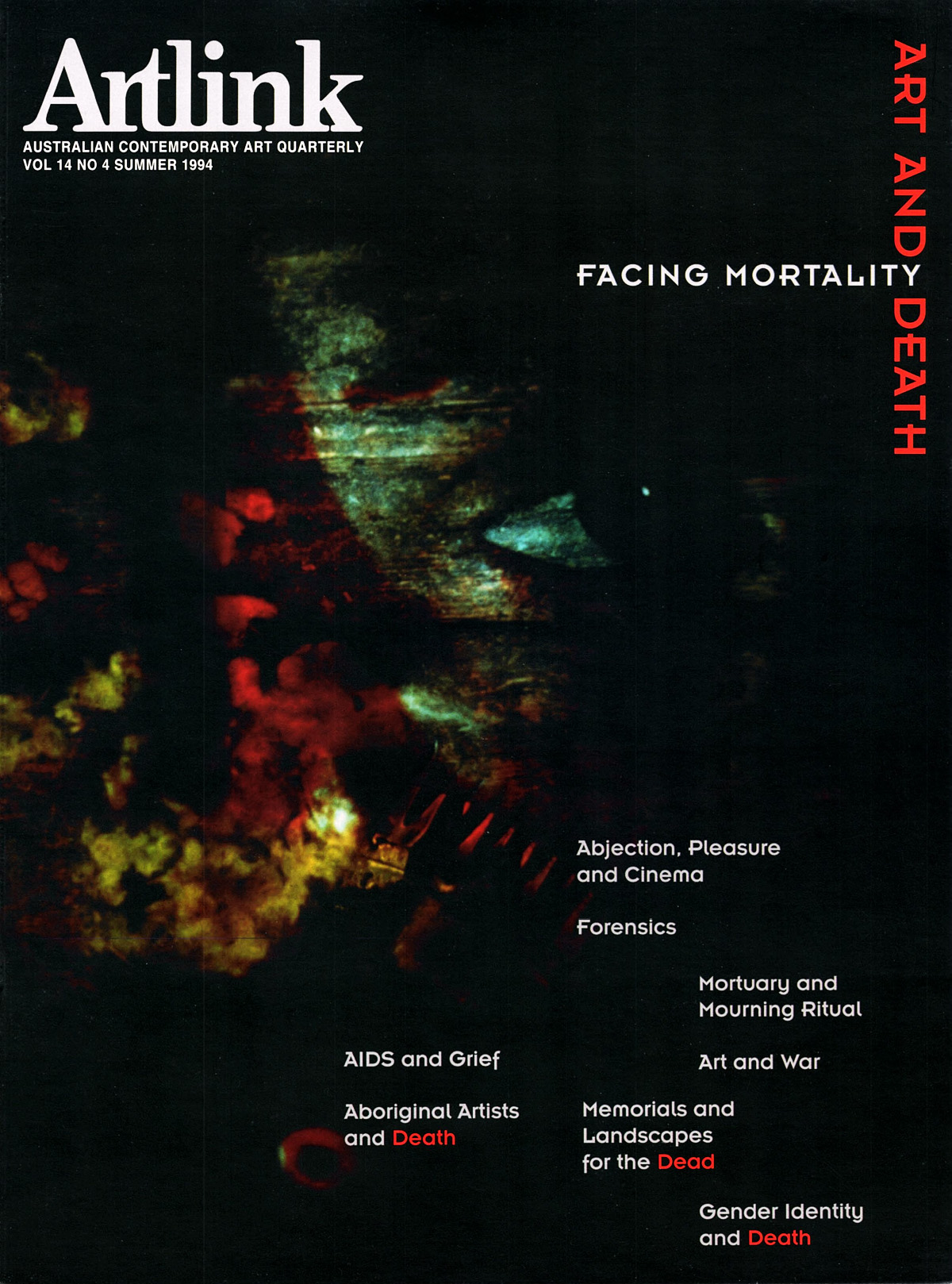
Art & Death: Facing Mortality
Issue 14:4 | December 1994
Guest editor Peter Bishop. Artlink looks at art and death, facing mortality, abjection - pleasure and cinema, forensics, mortuary and mourning ritual, art and war, AIDS and grief, Aboriginal artists and death, memorials and landscapes for the dead, gender identity and death. A challenging issue.
In this issue
Editorial: Australasian artists' responses to death
What is indefinable is defined
Mourning: Traditions, Symbols and Meaning
Grief and the Gay Community
While AIDS does indeed affect everyone in our society, at the moment in Australia we are seeing predominantly a gay and lesbian artistic response to the epidemic.
Learning to Understand: Art Helps to Dispel Ignorance
The artist looks at the paintings which were developed for the Health Commission on education, prevention and caring in the AIDS environment. Using an Aboriginal perspective these paintings were produced as a powerful series of posters.
Kumantji and the Contemporary Curator
Across much of Aboriginal Australia the announcement of a death is followed by profound communal mourning, the removal or destruction of the deceased's belongings and most significantly a prohibition on the use of the deceased's name.
Death's Artefact... Recent Art and War
Women's War Memorials
A Cemetery for the Community: Enfield Memorial Park, South Australia
Thus we come full circle to view the cemetery not as a necessary inconvenience to be isolated on the edge of town and visited once every few years but as a resource that can make a positive contribution to the community.
Death in Excess: Nuclear Imagery
Nuclear conflagration - whether real or imagined - captivated the post war psyche. Endist images of one form or another were developed in response to what many foresaw as the likely outcome of a third world war.
In the Coil of Life's Hunger
Looks at the work of James K Baxter 1926 - 1972 (poet) Colin McCahon 1919 - 1987 (artist) both of whom found in travel through New Zealand recurrent metaphor's for life's journey. The principle referent in their work was death.
Animal Death and an Artist's Culture: Brian Blanchflower's Tursiops Installation
Examination of the installation Tursiops by Brian Blanchflower which refers to the brutal heritage of Western Australia's first settlement at Albany which had a large whaling station until the late 1970s.
And Love a Fantasy: Breastfeeding our Sexuality
On 17 March 1993, the body of photographer Angelo Campana was discovered in the burnt out remains of the newly opened IEG Waste Recycling Plant in Corrimal. According to the coroner's report, his death had not been caused by this fire, but from fatal head injuries incurred by the deceased's head being repeatedly bashed with a theodolite. This is the immediate crime which is appears to be investigated in Dennis Del Favero's sleuthian compilation of words and images, objects and installations called 'Prima Facie'.
Guide to...Image Bank
Exploration of images and statements by artists on the theme of death. Artists include William Kelly, Ross Moore, Bette Mifsud and Dennis Del Favero.
Death, Pleasure and Gender in Film
The cinema's ability to represent death - the act of dying, bodily transformations, decay, the corpse - in astonishing realistic terms helps to explain why film, the moving rather than the static image, has become the central depository of death narratives (ancient and modern) in contemporary culture.
Cinema, Death and the Abject
Cinema is both dead and deathless. Cinema like this can take us to the great chasm in our lives and hold us over the edge.
Death: A Post-Mortem
Looks at the exhibition 'Death' co-curated by Felicity Fenner and Anne Loxley held at the Ivan Dougherty Gallery in April 1993. 'Death' was a mixed media survey covering more than 200 years of Australian art which directly addressed the theme of death.
600,000 HOURS (Mortality) Conference Day 21 October 2, 1994
Examination of the issues addressed at the conference which accompanied the exhibition 600,000 hours (mortality).
Images of Death 600,000 HOURS (Mortality) Experimental Art Foundation
Images of death explored in the context of the exhibition 600,000 hours (mortality) held at the Experimental Art Foundation, Adelaide South Australia October 1994.
No Drop City: Contemporary Australian Architecture
Book review Contemporary Australian Architecture
Graham Jahn
Photography by Scott Frances
Basel/East Roseville: Gordon and Breach International/Craftsman House 1994 241 pp
Indecent Exposures and Dissonance: Two New Books from Catriona Moore
Book reviews Indecent Exposures: Twenty years of Australian Feminist Photography
By Catriona Moore
Allen & Unwin in association with the Power Institute of Fine Arts
206 pp $21.95
Dissonance: Feminism and the Arts 1970 -90
Edited by Catriona Moore
Allen & Unwin in association with Artspace
308 pp $21.95
A Paradigm Exhibition
Exhibition review Perpetual Motion: Aboriginal Strategies for rejigging art and technology
Curated by David Kerr and Doreen Mellor
Tandanya National Aboriginal Cultural Institute, Adelaide South Australia 8 July - 14 August 1994
Symmetry: Craft Meets Kindred Trades and Professions
Exhibition review Symmetry: Crafts and Kindred Trades and Professions Curated by Kevin Murray
University of South Australian Art Museum
8 September - 8 October 1994
Monstrous Gorgeous
Exhibition review Monstrous Gorgeous
Curated by Virginia Barratt
Contemporary Art Centre, Adelaide, South Australia
8 July - 7 August 1994
Fania
Exhibition review Fania
Curated by Erica Green
University of South Australia Art Museum
28 July - 27 August 1994
Chris Hopewell
Exhibition review Chris Hopewell: New works
Lawrence Wilson Art Gallery at the University of Western Australia
2 September - 16 October 1994
19th Fremantle Print Award
Exhibition review The Nineteenth Fremantle Print Award
Fremantle Arts Centre, Western Australia
9 September - 23 October 1994
Familiarity? Re-Examining Australian Suburbia
Exhibition review Familiarity? Re-examining Australian Suburbia
Mikala Dwyer, Michele Beevors, Glen Clarke, Elizabeth Woods, Tony Schwenson and Aleks Danko
Curated by Brian Parkes
Plimsoll Gallery, University of Tasmania
23 September - 16 October 1994
Crossovers - Site Works and Symposium
Exhibition review Crossovers: Site works and symposium
Tasmanian School of Art and various locations, Launceston, Tasmania 26 September - 2 October 1994
